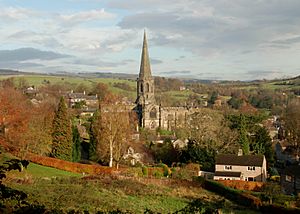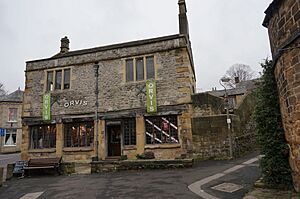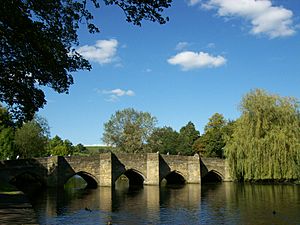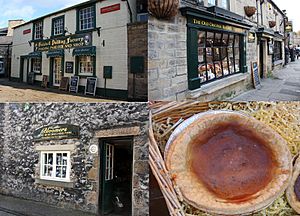Bakewell facts for kids
Quick facts for kids Bakewell |
|
|---|---|
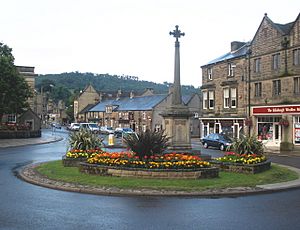 Bakewell town centre |
|
 Bakewell parish highlighted within Derbyshire |
|
| Population | 3,949 |
| OS grid reference | SK2168 |
| Civil parish |
|
| District |
|
| Shire county | |
| Region | |
| Country | England |
| Sovereign state | United Kingdom |
| Post town | BAKEWELL |
| Postcode district | DE45 |
| Dialling code | 01629 |
| Police | Derbyshire |
| Fire | Derbyshire |
| Ambulance | East Midlands |
| EU Parliament | East Midlands |
| UK Parliament |
|
Bakewell is a busy market town and civil parish in the Derbyshire Dales area of Derbyshire, England. It is famous for its delicious Bakewell pudding. The town sits by the River Wye, about 23 kilometers (15 miles) southwest of Sheffield. It is the biggest town inside the Peak District National Park. In 2011, about 3,949 people lived in Bakewell. The town is also close to popular places like Chatsworth House and Haddon Hall.
Contents
History of Bakewell
Even though people lived in this area earlier, Bakewell itself probably started in Anglo-Saxon times. This was when England was made up of different kingdoms, and Bakewell was in the kingdom of Mercia. The name Bakewell means "a spring or stream belonging to a woman named Badeca or Beadeca."
In old records, it was called Badecanwelle in 949. In the 1086 Domesday Book, a very old survey of England, it was called Badequelle. The Domesday Book said that King Edward the Confessor owned land here, and there was already a church and a mill.
By the time of the Normans, Bakewell became more important. The Domesday Book mentions the town and its church having two priests. A motte and bailey castle (a type of early castle) was built in the 12th century.
A market was started in 1254. This helped Bakewell grow into an important trading center. The five-arched bridge over the River Wye is from the 13th century. It is one of the few old parts of the town still standing. Another old bridge, Holme Bridge, was built in 1664. It also crosses the Wye on the edge of town.
In 1697, a special spring with iron in its water was found, and a bath house was built. This led to people trying to make Bakewell a spa town like Buxton in the 1700s. Later, Richard Arkwright built Lumford Mill in 1777. This led to many parts of the town being rebuilt in the 1800s. The mill, built around 1782, employed over 300 people at its busiest. Today, it is a protected historical site. Bakewell has 183 buildings that are officially protected because of their history.
Geography of Bakewell
Bakewell is in the valley of the River Wye in the middle of Derbyshire. The town center is about 125 meters (410 feet) above sea level. The highest parts of the town are about 185 meters (607 feet) high on the valley sides. Bakewell is in the Derbyshire Dales area. It is about 24 kilometers (15 miles) southwest of Sheffield and 50 kilometers (31 miles) southeast of Manchester. Nearby towns include Matlock to the southeast and Buxton to the west.
 |
Eyam and Hope Valley |  |
||
| Macclesfield and Buxton | Chesterfield | |||
| Youlgreave and Derby | Matlock |
Bakewell's Economy
Bakewell is a popular place for both local and international tourists. Mondays are especially busy because it's the town's traditional market day. The cattle market is held in a special building across the river. There is also a stall market in the town center.
A big employer in Bakewell is the Peak District National Park Authority. Their job is to protect, improve, and help people enjoy the local area. Another important employer is Newholme Hospital, an NHS hospital that provides healthcare services. When a Costa Coffee shop opened in town, it caused some discussion among local businesses.
You can watch local news from BBC East Midlands and ITV Central in Bakewell. Local radio stations are BBC Radio Derby and Peak FM.
Landmarks in Bakewell
All Saints' Church is a very old church. It was started in 920, during Saxon times. It is a "Grade I-listed" building, which means it is very important historically. The churchyard has two ancient Saxon crosses. One is the Beeley Cross, which is over 1.5 meters (5 feet) tall. The other is the Bakewell Cross, which is about 2.4 meters (8 feet) tall and shows scenes like the Annunciation.
During repairs in the 1840s, many carved pieces of Saxon stone were found around the church. The church also has old stone coffins. Inside, you can see medieval and Anglo-Saxon stone fragments. There is also a special alabaster memorial to Sir Godfrey de Foljambe, who owned Bakewell around 1350, and his wife Avena.
The town's Old House Museum is in a house from the 1500s. It started during the time of Henry VIII and was made bigger under Elizabeth I. It is a "Grade II*-listed" building, also very important.
The Old Town Hall on King Street dates from 1602. The current Town Hall, on Anchor Street, was finished in 1890.
Transport in Bakewell
Railway
The Manchester, Buxton, Matlock and Midlands Junction Railway opened Bakewell railway station in 1862. This line later became part of a main railway route from London to Manchester. The writer John Ruskin did not like the railway, saying it spoiled the countryside. He also joked that "every fool in Buxton can be at Bakewell in half an hour."
The Bakewell station buildings are quite grand because the railway needed permission from the Duke of Rutland to pass through his land. The Duke's coat of arms is even carved into the stone. The Duke also wanted the station to be out of sight of his home, Haddon Hall. This meant the station was built a bit outside the town.
The railway line through Bakewell closed in 1968. Most of it is now the Monsal Trail, a path for walking, cycling, and horse riding. Passenger trains today only go as far as Matlock from the south and Buxton from the west. There are hopes to reopen the line through Bakewell in the future. Peak Rail, a local group, has already reopened part of the line from Matlock to Rowsley.
Roads
The A6 road goes through Bakewell. This road connects Bakewell with Buxton, Matlock, and Derby.
The A619 road starts in Bakewell. It goes through Chesterfield and leads to Worksop. The old Bakewell Bridge carries this road over the River Wye.
Bakewell Cuisine
Bakewell is famous for its Bakewell pudding. This is a sweet pastry with jam and a filling made with egg and ground almonds. A Bakewell tart is a bit different. It has a shortcrust pastry base, a jam filling, and an almond sponge topping.
The story of how Bakewell pudding began is quite interesting. It is said that in 1820, the landlady of the White Horse Inn (now the Rutland Arms Hotel) told her cook to make a jam tart. But the cook put the egg and almond paste on top of the jam instead of mixing it into the pastry. When it was baked, the jam rose through the paste. People loved it, and it became a popular treat at the inn.
Today, three shops in Bakewell say they have the original recipe for Bakewell pudding. The Bakewell Tart Shop and Coffee House sells different kinds of Bakewell tarts and the traditional pudding. The Old Original Bakewell Pudding Shop and Bloomers of Bakewell also sell their own Bakewell Pudding.
Demography
In the 2011 census, most people in Bakewell (99.1 percent) were White.
Education in Bakewell
In 1888, William Storrs Fox, a naturalist, started St Anselm's School, Bakewell. This school now has about 250 students aged 3 to 16. Lady Manners School is a secondary school with about 1,450 students. Bakewell is also home to the Brew School, which teaches brewing and distilling. It opened in 2014 at the old Rutland Mill.
The town's primary schools include All Saints Church of England School and Bakewell Methodist Junior School. There are also other primary schools in nearby villages.
Sights to See
- Old House Museum
- All Saints' Church
- Bakewell Bridge
- Holme Bridge
- Weir Bridge
- Lumford Mill
- Bagshaw Hall
- Bakewell War Memorial
Events in Bakewell
In June, Bakewell has its traditional well dressing. This is when colorful pictures made from flower petals are placed at several spots in town. After that comes Carnival week, which ends with a big parade in early July. In August, the Bakewell Arts Festival takes place, offering music and theater. The Peak Literary Festival is held twice a year, in spring and autumn.
Until 2017, The Bakewell Agricultural Show was one of the biggest agricultural shows in the UK. It attracted about 65,000 visitors. It was held in early August at the Bakewell Showground. The show was paused in 2018 and 2019 for other commercial events.
Sport and Recreation
Rugby union is played regularly by Bakewell Mannerians RUFC.
Bakewell has a recreation park east of the town center. It has tennis courts, a playground for children, and pitches for football and cricket. Near the library, there is a swimming pool and a gym. The River Wye offers a nice path for riverside walks.
The town's association football (soccer) team, Bakewell Town F.C., plays in the Central Midlands Football League.
Media
In Literature
Bakewell is mentioned in Jane Austen's famous book Pride and Prejudice. The main character, Elizabeth Bennet, says she traveled from Bakewell to Pemberley.
On Television
- Bakewell appeared in an episode of Most Haunted: Midsummer Murders.
- In 2010, the Rutland Arms Hotel was featured in an episode of The Hotel Inspector.
- For "Puddings Week" in the first season of The Great British Bake Off, the famous tent was set up in a car park in Bakewell.
See also
 In Spanish: Bakewell para niños
In Spanish: Bakewell para niños


